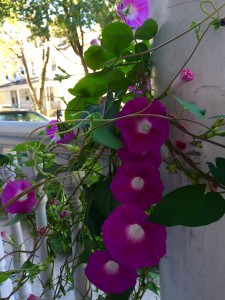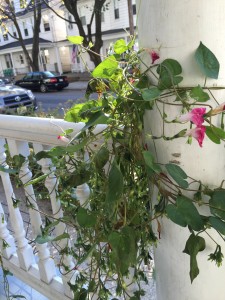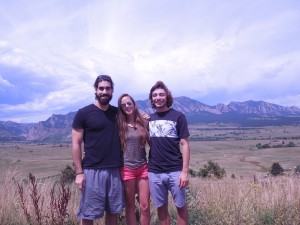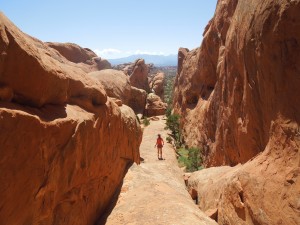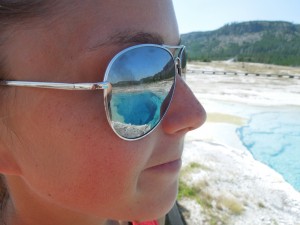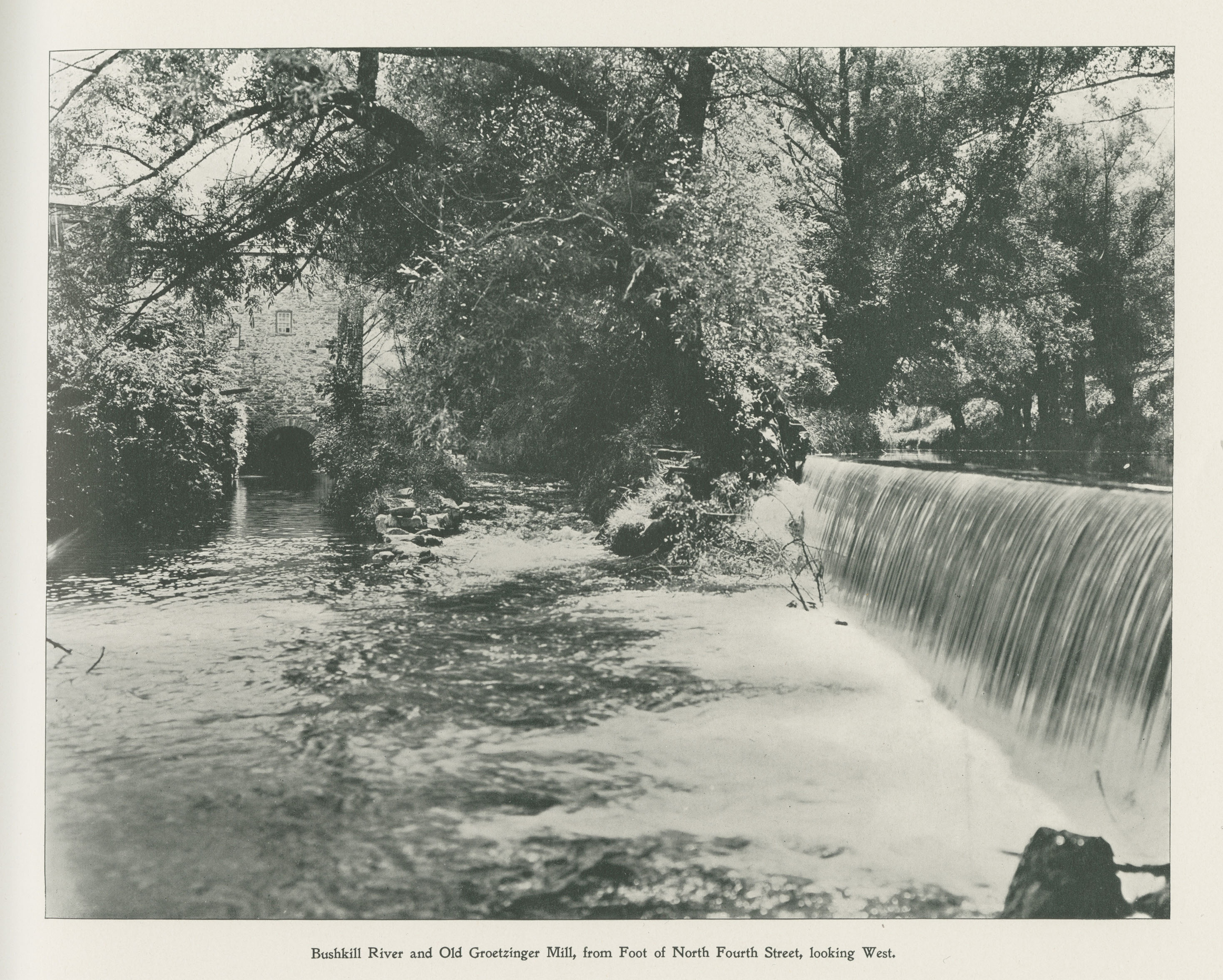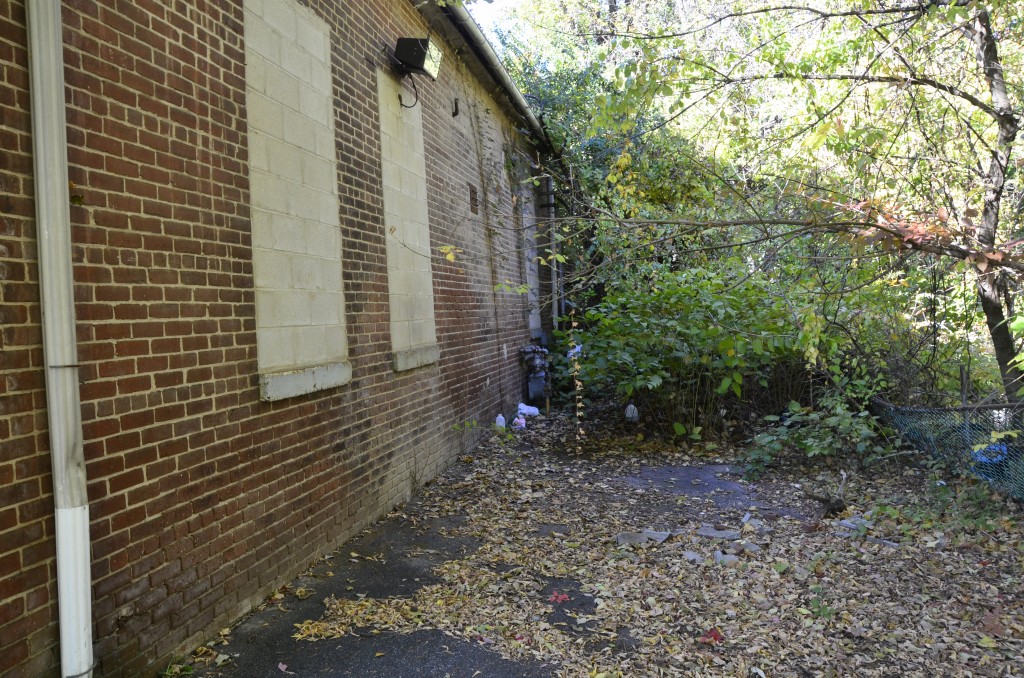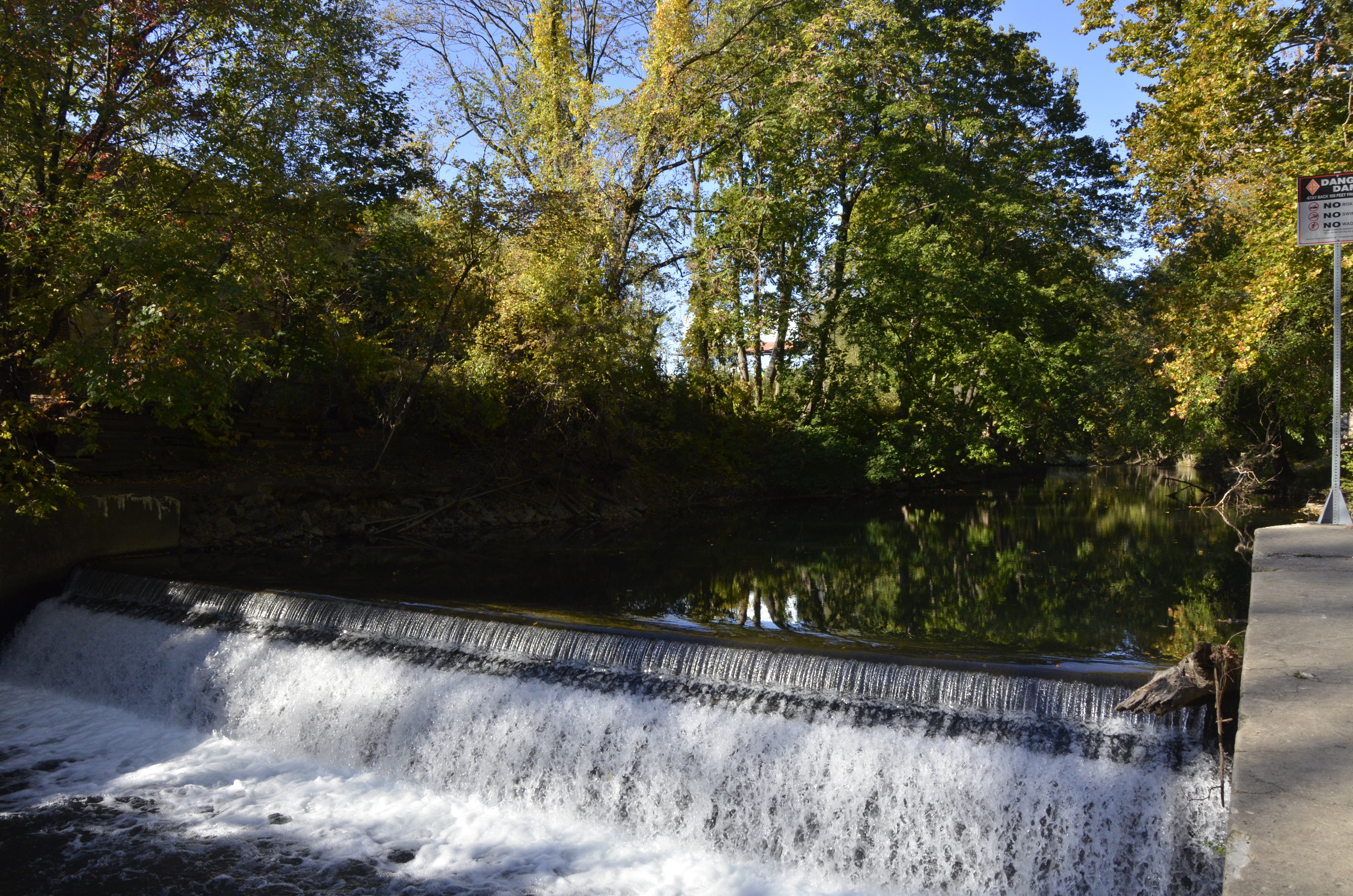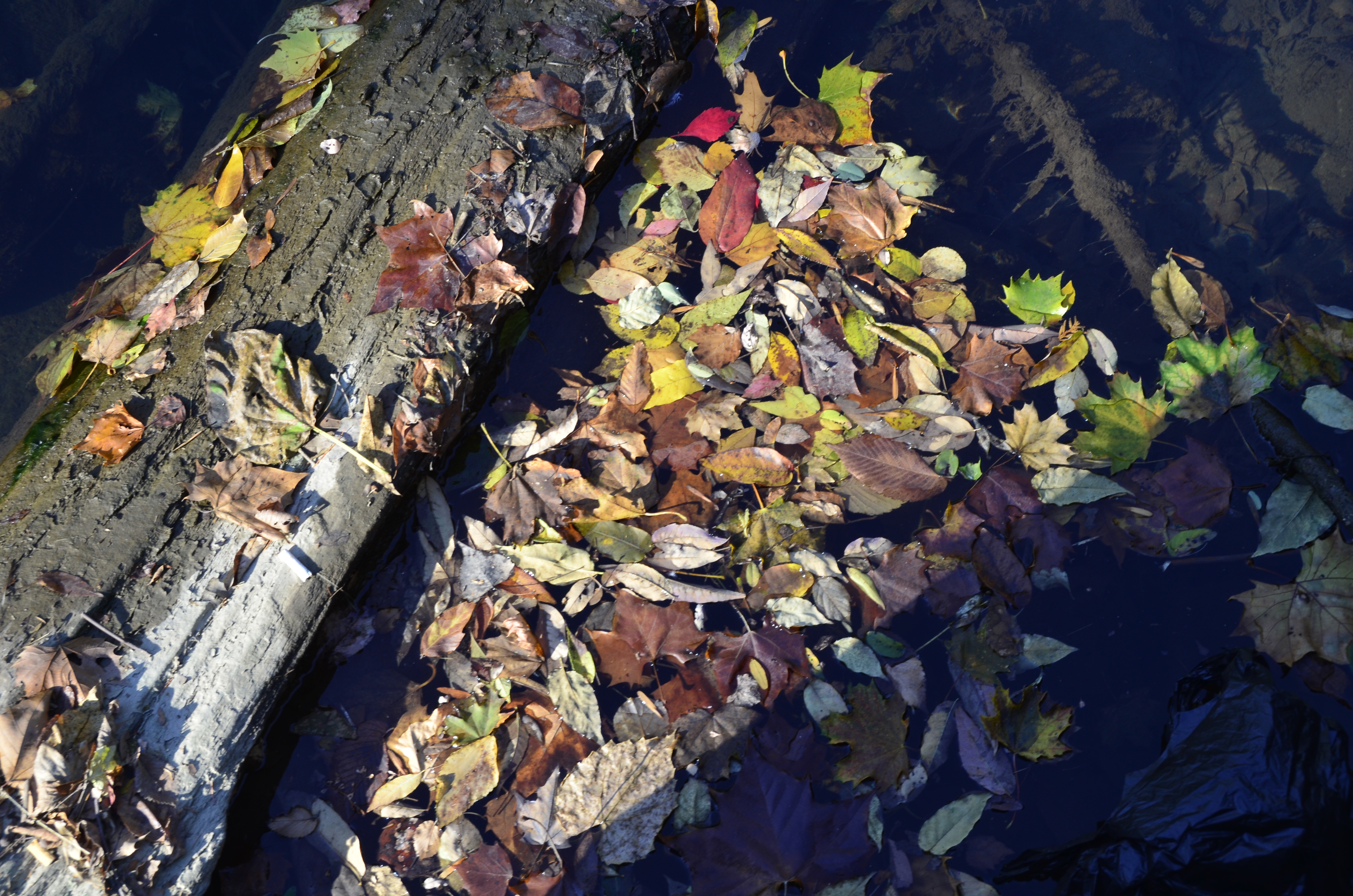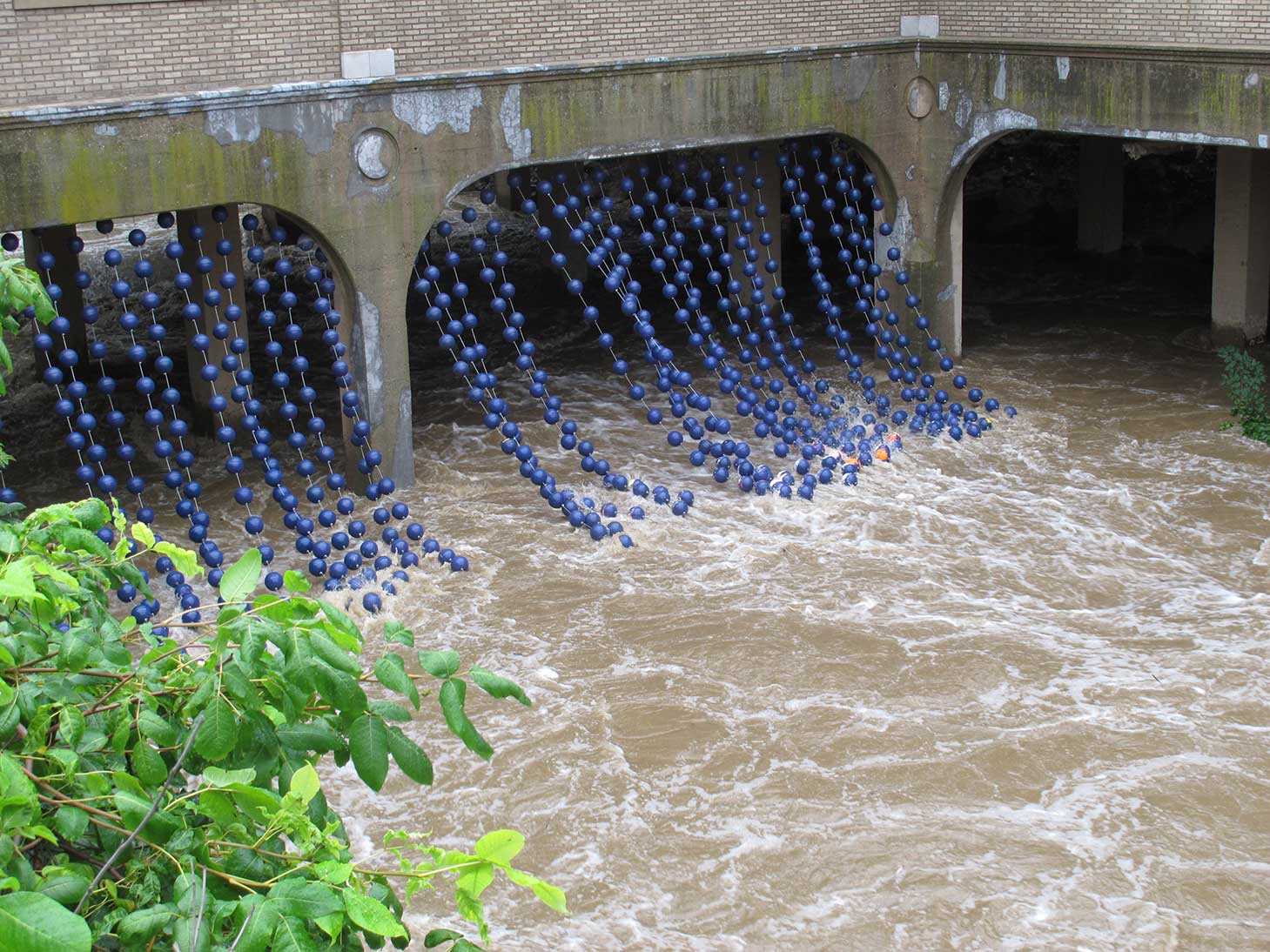Earlier this semester I posted the picture of the morning glories on the left. They were beautiful in full bloom, even though they had taken over the front porch. Unfortunately, in cold on Sunday and Monday my morning glories did not survive. This vine is now a very sad sight.
Category Archives: Uncategorized
Quotes from Tallamy
“If our native insect fauna cannot, or will not, use alien plants for food, then insect populations in areas with many alien plants will be smaller than insect populations in areas with all natives. This may sound like a gardener’s dream: a land without insects! But because so many animals depend partially or entirely on insect protein for food, a land without insects is a land without most forms of higher life (Wilson 1987)” (Tallamy, 12).
“Nearly every creature on this planet owes its existence to plants, the only organisms capable of capturing the sun’s energy and, through photosynthesis, turning that energy into food for the rest of us. Only in the deepest reaches of the ocean do life forms survive that don’t require this food, deriving their energy through chemosynthesis of sulphur’ from deep-sea vents (Ruby, Wirsen & Jannasch 1981: Novomv et al. 2006)” (Tallamy, 15).
Passages of Interest
“This may sound blasphemous, but maintaining native biodiversity is less important than maintaining a functioning ecosystem. What matters is that soil is protected, that water gets cleaned, that trees filter the air, that a canopy regenerates new seedlings to keep nutrients from draining away into the Bronx River.”- Chuck Peters of the New York Botanical Garden in The City Without Us, page 39
I think this statement is a very controversial one that would cause a big fight among people that strive to protect biodiversity. In EVST Capstone we read an article about a writer named Johnathan Franzen who thought that protecting biodiversity was more important than preventing climate change. According to Franzen, Climate change has gone too far and there is nothing left to be done about it. Franzen believes that we should continue individual biodiversity efforts for threatened and endangered species. I think Peters’ point is that if we want to sustain the earth in such a way that humans can continue to prosper, we should care less about biodiverstiy and more about just protecting green spaces in general. I would be very interested to see a Franzen response to Peters’ statement. I am surprised that Peters, as someone who works at NTBG, would have such a statement about biodiversity.
“Our perception has always been that, no matter how many subdivisions we build, or how much land we put to the plow, or how many roads we construct, there will always be plenty of undisturbed space left” No Place to Hide, page 27
I can’t remember what passage it was that we discussed but this makes me think a lot about the closing of the frontier. In the 19th century there was this perception that the wilderness went on forever. In 1890, the US Census Bureau declared that the frontier officially closed. Still today, people are ignorant of the fact that their cannot be endless development. We will eventually run out of resources and space.
Thoreau: Pond Scum
I stumbled upon this very interesting article published a few days ago about Thoreau. While, I don’t agree with many of the authors points, it is interesting viewing Thoreau in the opposite light from which we have been discussing him for the past semester. Below are a few of the most interesting quotes I found, but the whole article is worth reading. Let me know if you think the author has any valid points.
“The real Thoreau was, in the fullest sense of the word, self-obsessed: narcissistic, fanatical about self-control, adamant that he required nothing beyond himself to understand and thrive in the world.”
“But “Walden” is less a cornerstone work of environmental literature than the original cabin porn: a fantasy about rustic life divorced from the reality of living in the woods, and, especially, a fantasy about escaping the entanglements and responsibilities of living among other people.”
“Like his fellow-transcendentalists, he was suspicious of tradition and institutions, and regarded personal intuition and direct revelation as superior foundations for both spiritual and secular beliefs. Unlike his fellow-transcendentalists, he also regarded his own particular intuitions and revelations as superior to those of other people.”
http://www.newyorker.com/magazine/2015/10/19/pond-scum
Corn: We need it and it needs us
Corn is a fascinating organism. We use corn for everything from food to biofuel to feed for farm animals. A DNA test of a single human hair shows that the average American’s carbon content is 69% from corn. That’s a huge percentage! So clearly we have some form of dependency on corn in our lives the way that they are operating today. What I find fascinating though is that corn needs us in order to reproduce. Should humans vanish off the face of the earth today, corn would vanish with us. The nature of the kernel, covered carefully in its husk and in extreme close proximity to many other kernels would not be able to disperse or survive without the help of human propagation. I find this to be quite ironic, our co-dependency upon one another, humans and corn.
Photograph or Photocopy?
(I wrote this a few weeks ago but appear not to have published it, oops!)
I thoroughly appreciated President Byerly’s interpretation of the National Parks system as an aesthetic manipulation of the American landscape (as I read it from my sun-baked seat on the quad yesterday afternoon) because I felt she explored it philosophically and with passion. Though I’m sure you’re all feeling beaten over the head with it by this point, this piece clearly reminded me of my trek around some of America’s National Parks in the West/Southwest. As we toured a number of the parks I was often annoyed by the hoards of humans with their selfie sticks and flashing cameras all crowded around the same “scenic view” or “outlook point”. And yet these are the places we feel compelled to go to because it feels as though someone is telling us, “hey- over here, this is what you’re looking for!”
My particular experience with the parks was very naive and unplanned and wholly beautiful. For the majority of the trip I was only with my boyfriend Sacha, who is at least as naive and unplanned as I, so our curiosities about the parks and what they could offer us were usually fulfilled- no matter how that seemed to turn out (many a sore limb and grumbling tummy did result form our choices). I thought it might be interesting to include here some photos that I feel resulted from some of our treks off the beaten path as well as some that are so cliche they merit a cringe or two. I would like to think of these ideas here as I think Byerly’s philosophy might dictate- as either photographs or photocopies.
~photocopies~
a tripod shot of the Colorado Flatirons so touristy my CO-native friend Topher (shown right) laughed and ran away moments after the shot.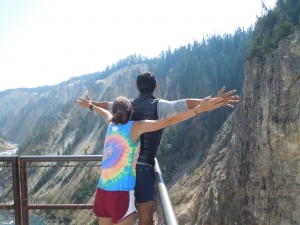
the “Titanic pose” at perhaps the most crowded “overlook” we visited, at the Grand Canyon of Yellowstone.
~photographs?~
at Arches National Park, Sacha and I took a detour into what we thought might have been a trail but turned out definitely not to be. I would imagine this isn’t a shot you see on the postcards.
very touristy but striving for a “different” take on the “Sapphire Pool” at Yellowstone National Park.
a shot from the previously blogged-about explorative hike up into what we hoped would be bear country. in this moment the view felt untouched, and I think represented an appreciation for the park (Yellowstone) not tarnished by its economically relevant beauty.
Story of Place: Update 4
This past week we decided to reinvestigate the history of our sight and specifically the mills that used to be there.
We began by looking at old pictures of the site and happened upon on captioned ‘Old Groetzinger Mill’ and thought to look into this site. This led us to find out that this Groetzinger Mill was actually located at our site at the end of N. 4th Street in Easton across from Goose Island on the Bushkill. The Groetzinger family operated the mill for nearly half a century from the late 19th and early 20th century. This seemed to us to be an excellent example of the unique story of this part of the Bushkill.
Another article we found said that as early as the 1870’s there have been attempts to set up salmon fisheries on the Bushkill because of their ability to benefit the health of the stream. While the stocking of Atlantic salmon in the Bushkill seemed to be relatively unsuccessful, the people of the Easton area were clearly committed to the idea of manipulating nature to their own advantage.

“this fist is a fact, and in official hands will be irrefutable evidence that the stocking of our rivers with the most valuable fish in the world is not visionary but predictable.”
Today however, the remains of these mills are gone and the general respect for the natural benefits of the Bushkill are lacking as well. Both sides of the creek are thoroughly overgrown, making it difficult to find any historical evidence of previous human development. From a natural standpoint, the Bushkill Creek used to be the center of attention in the area, with humans settling and developing in harmony with the creek. Today, it seems as if the community has built up and around the creek, ignoring any potential aesthetic or practical use. The arts building that bridges the creek is symbolic of the idea that Easton no longer values the creek as local residents once did. It has literally been built over, out of sight and out of mind, providing little more than a source of runoff from the surrounding streets or a shelter for the homeless.
On the Downtown side of the creek, next to the parking lot, is an old abandoned building. It is not old enough to have a relation to the Groetzinger Mill, but it may be built over the original area of the mill. It is so close to the water that we wonder if the creek’s banks were filled in to support such a large building.
On a separate note, the foliage along the creek seems to be changing more slowly that the rest of the area. The leaves on the trees are just barely starting to turn, while the ground cover and shrubbery still looks nearly as full and as green as it did in September. The water level also seems to remain relatively steady.
Final thoughts: We learned a bit more about the artwork hanging from the arts building. Stacy Levy created the piece in 2011. “Bushkill Curtain spans the Bushkill Creek in Easton, Pennsylvania, using the arched opening under an old silk mill. The water flow of the creek varies widely depending on rainfall. Bushkill Curtain will register the changing levels of water, hanging straight down in low water or floating on the surface as the stream rises. It also responds to the wind, blowing like a sheer fabric. This temporary project (June 2011 through August , 2012) was created for The Arts in the Urban Environment Festival. This site is a juncture where the masonry of the industrial architecture meets with the liquid nature of a stream. The curtain creates a meeting point of manmade materials with the elements of wind and water. It is made of 750 buoys strung on steel cable.”
Quotes from Readings 10/19
From The World Without Us – “With no more people, there won’t be salt. There will, however, be rust and quite a bit of it, when no one is painting the bridges.” (42)
This is specifically speaking of New York City’s bridges that will continue thriving if they are maintained. Similar to most structures in NYC, without the human maintaining them, they will quickly deteriorate at the hand of nature.
From Walden – “At length, having come up fifty rods off, he uttered one of those prolonged howls, as if calling on the god of loons to aid him, and immediately there came a wind from the east and rippled the surface, and filled the whole air with misty rain, and I was impressed if it were the prayer of the loon answered, and his god was angry with me; and so I left him disappearing far away on the tumultuous surface.” (258)
Thoreau in this section believes that the loon he is ‘playing’ with can understand human instinct and the loon ‘himself’ is capable of “calling on the god of loons”. The loon “laughs” and “balks” at Thoreau, so he makes the loon feel like a human almost, yet make sure to distinguish that the loon is an animal and calls upon a different god to answer his prayers.
Quotes
“There too I admired, though I did not gather, the cranberries, small waxen gems, pendants of the meadow grass, pearly and red, which the farmer plucks with an ugly rake, leaving the smooth meadow in a snarl, heedlessly measuring them by the bushel and the dollar only, and sells the spoils of the meads to Boston and New York; destined to be jammed, to satisfy the tastes of lovers of Nature there” (Thoreau, 259).
“Some people want to put the forest back the way it was 200 years ago,” he says. “To do that, I tell them, you’ve got to put the Bronx back the way it was 200 years ago” (Weisman, 35).
Passages of Interest
“Hermit alone. Let me see: where was I? Methinks I was nearly in the frame of mind; the world lay about at this angle. Shall I go to heaven here or go fishing? If I should bring this meditation to an end, would another sweet occasion be likely to offer?” (Thoreau 245).
This passage stood out to me as it seems Thoreau is very clearly pointing out this transcendental moment he is having by himself, that he is in this state at this perfect “angle” for the moment and changing this would jeopardize the important, hard-to-find moment.
“I pursued with a paddle, and he dived, but when he came up I was nearer than before. He dived again, but I miscalculated the direction he would take, and we were fifty rods apart when he came to the surface this time, for I had helped to widen the interval; and again he laughed loud and loud, and with more reason than before” (Thoreau 255).
Throughout this chapter Thoreau gives many of his “neighbors” in the form of animals personality. One example of when I saw this was during his interaction with the loon; I found this perspective that extended personality to the animals around him and to view them as neighbors to be interesting and entertaining.

